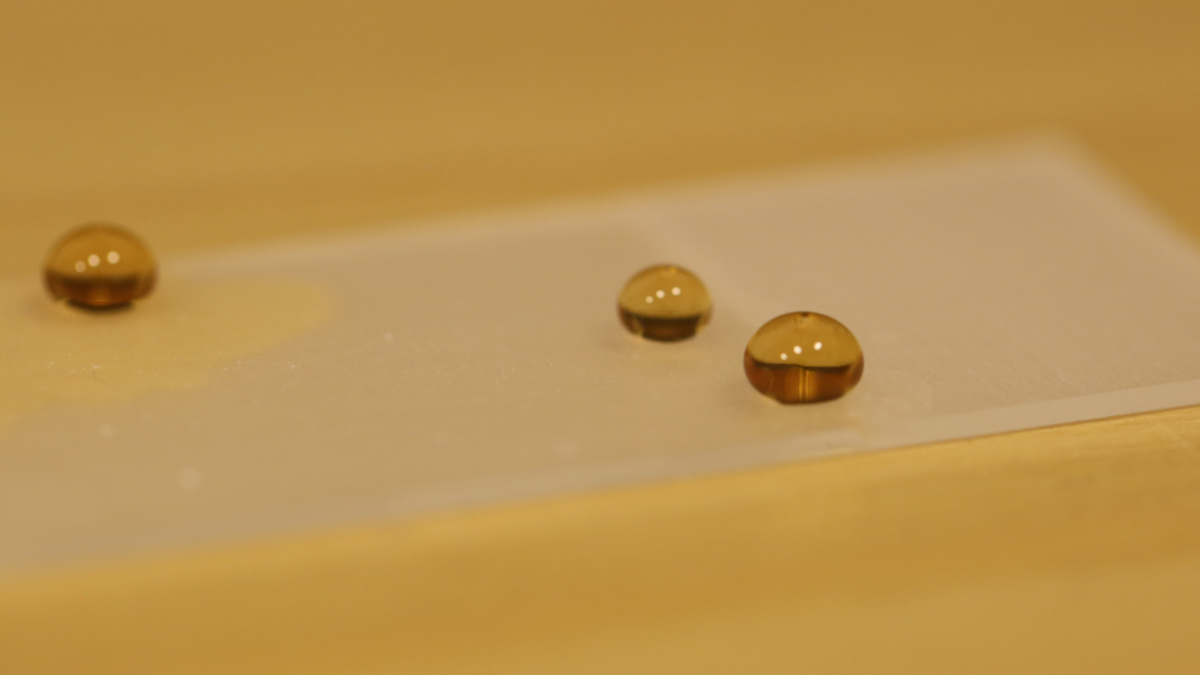
Water flows more quickly than honey – except, perhaps, when it doesn’t.
Physicists in Finland were surprised to find that in narrow tubes coated with compounds that repel liquids, the more viscous that liquid is, the faster it flows.
In fact, they report in a paper in the journal Science Advances, glycerol, which is a thousand times more viscous than water, was seen to flow 10 times faster.
And that’s more than just a physics fun fact. The speed at which fluids flow through pipes is important for a large range of applications, from industrial processes to biological systems.
You can make liquids flow faster by increasing the pressure, but that has obvious risks, particularly in thin or narrow pipes. A team at Aalto University decided to experiment with superhydrophobic coatings.
“A superhydrophobic surface consists of tiny bumps that trap air within the coating, so that a liquid droplet that rests on the surface sits as if on a cushion of air,” says research leader Robin Ras.
The coatings themselves don’t speed up the flow of the more viscous liquids, Ras explains. If you place a drop of honey and a drop of water on a coated surface then tilt it to let gravity do its work, the low-viscosity water will flow more quickly.
However, when a droplet is confined to one of the very narrow tubes used in microfluidics, things change drastically. The superhydrophobic coating creates a small air gap between the inside wall of the tube and the outside of the droplet.
“What we found was that when a droplet is confined to a sealed superhydrophobic capillary, the air gap around the droplet is larger for more viscous liquids,” says first author Maja Vuckovac. “This larger air gap is what allowed for the viscous fluids to move through the tube faster than the less viscous ones when flowing due to gravity.”
The crucial discovery, says co-author Matilda Backholm, was that less-viscous liquids also managed to penetrate a bit into the air cushion surrounding the droplets, rendering a thinner air gap around these.
“This means that the air beneath a low-viscosity droplet in the tube couldn’t move out of the way as fast as for a more viscous droplet with a thicker air gap,” she says. “With less air managing to squeeze past the low-viscosity droplets, these were forced to move down the tube with a slower speed than their more viscous counterparts.”
As part of their work, the researchers developed a fluid dynamics model they say can be used to predict how droplets would move in tubes coated with different superhydrophobic coatings.
There are significant potential applications, they suggest, in microfluidics, a chemical engineering technique used to precisely control liquids in small quantities, and in manufacturing complex chemicals.
Nick Carne
Nick Carne is the editor of Cosmos Online and editorial manager for The Royal Institution of Australia.
Read science facts, not fiction...
There’s never been a more important time to explain the facts, cherish evidence-based knowledge and to showcase the latest scientific, technological and engineering breakthroughs. Cosmos is published by The Royal Institution of Australia, a charity dedicated to connecting people with the world of science. Financial contributions, however big or small, help us provide access to trusted science information at a time when the world needs it most. Please support us by making a donation or purchasing a subscription today.
"flow" - Google News
October 17, 2020 at 01:47AM
https://ift.tt/3kaf24i
Honey really goes with the flow - Cosmos
"flow" - Google News
https://ift.tt/2Sw6Z5O
https://ift.tt/2zNW3tO
Bagikan Berita Ini














0 Response to "Honey really goes with the flow - Cosmos"
Post a Comment